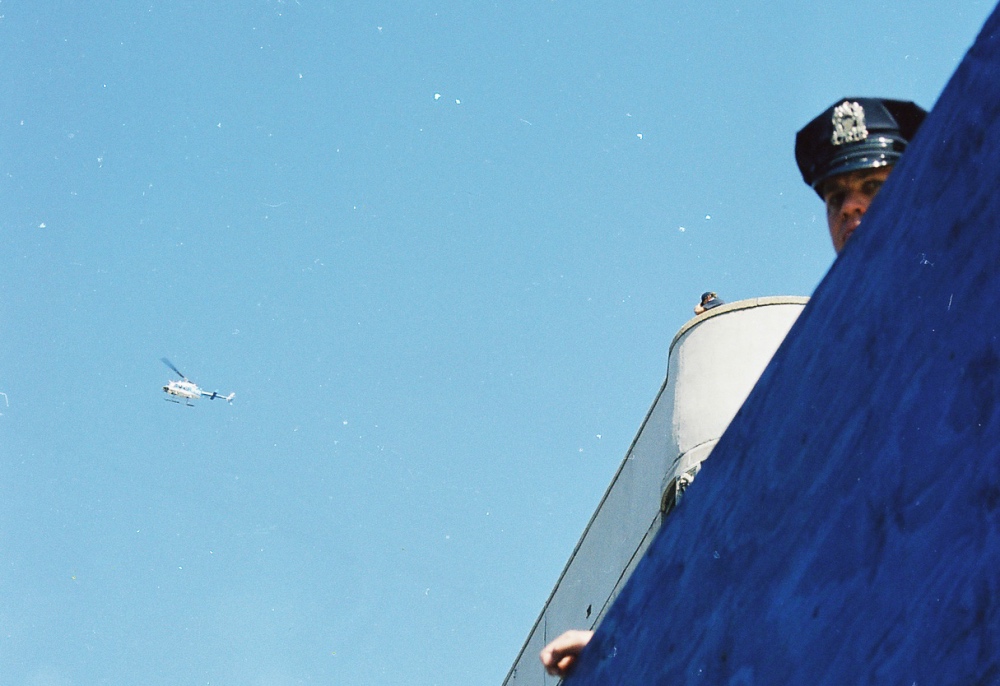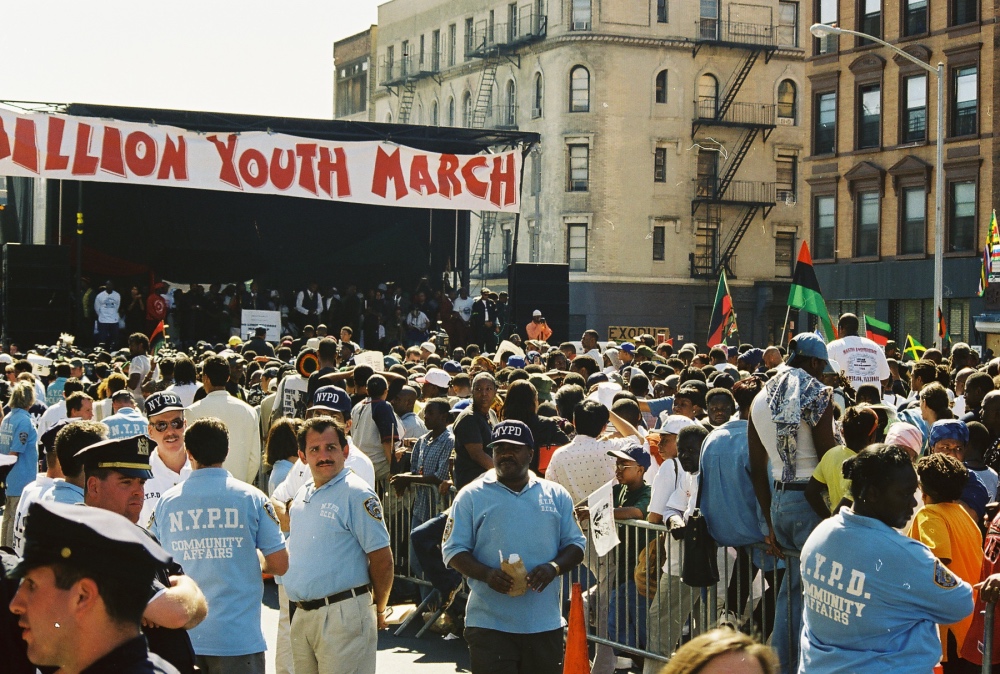
Against the backdrop of widespread protests over the death of George Floyd and racism in the US, Sight contributor CHRISTOPHER GILBERT reflects on his own experience while living in the US in the late 1990s and early 2000s…
Last updated 12.30pm AEST
How little we anticipate that the injustices we leave unresolved in one era fester into certain future eruptions.
Just after midnight on 8th May, 2005, seven shots rang out in the street below and I froze at my computer. I can still remember the booming pattern of them. I retreated from my attic studio, and made for the front door. The strobes of police emergency lighting already on the scene heightened my apprehension and suggested it had been police doing the firing.

Police and marchers in Harlem’s Malcolm X Boulevard on 6th September, 1998. PICTURE: Christopher Gilbert.
I had previously experienced a military-style response from police while living in Harlem but not a shooting like this and certainly not in the wide avenue of the leafy beachside town, Bradley Beach, that I was now living in on the Jersey Shore. A few houses up, three young police officers stood over the body of a very bloody white man who had six of their bullets in him. No amount of CPR made a difference.
At a press conference later that morning the district attorney explained that police on patrol had recognised the man as a passenger in a car filling up at a local garage. They followed the car and pulled it over in our street. The man was wanted on a warrant for failing to visit with his probation officer, out from prison for burglary with assault.
“As we observe the news coming from the US in June, 2020, there’s an unmistakeable narrative emerging from most media sources: The protesters are mostly cross generational, ordinary people fed up with a white majority police culture that profiles African Americans and has the habit too often of killing black men even when unarmed during arrests – and mostly with impunity. The list of victims across the US is long. And the violence we see on our screens which is so easily assumed to come from the protesters is in many cases initiated by aggressive policing. It’s how they’re trained.”
He had pulled a pocket-knife and held it to his own throat threatening to kill himself, the DA explained. One officer used pepper spray to no effect since as the man bolted from the car and tried to escape. The closest officer fired first; the other police fired most of the rounds in support. They had fired as they’ve been trained: to kill.
But really, did a threat of self-harm and a desperate bolt from the police constitute such a threat as to require deadly force? The DA spoke of “police suicide” as a possibility, while a family was left bereft, and three police officers had a killing on their conscience.
As an Australian-American dual citizen who spent 18 years living and working in New York City, New Jersey, and Boston’s North Shore, I indeed experienced some serious eccentricities of US law enforcement. This was just one. Still I rarely could convince fellow Americans that we inhabited a violent culture.
As we observe the news coming from the US in June, 2020, there’s an unmistakeable narrative emerging from most media sources: The protesters are mostly cross generational, ordinary people fed up with a white majority police culture that profiles African Americans and has the habit too often of killing black men even when unarmed during arrests – and mostly with impunity. The list of victims across the US is long. And the violence we see on our screens which is so easily assumed to come from the protesters is in many cases initiated by aggressive policing. It’s how they’re trained.
Many acknowledge that this is not a new issue, this is an issue as old as the United States itself. And while it seemed in the 1960’s that it would at last be addressed thanks to the civil rights movement, it was only a limited respite and did little to transform a culture of racism.
I observed that when teaching journalism in US colleges. Many of the mainly white students of the first decade of the millennium didn’t believe there was racism in their country anymore. But most had never studied the history of the civil rights movement and when shown a film series, Eyes on the Prize, would be as horrified as their north-eastern forebears at the violence visited upon those who joined Dr Martin Luther King, Jr, and the movements of people in the southern and later northern states.
Living in Harlem introduced me to African America. It pushed me towards an understanding of American history, its slavery, its civil war, its civil rights era. I formed friendships with people experiencing the pain of their second class citizenship. I was out of my depth and constantly humbled when my ethno-centric white Australian attitudes got in the way.

On rooftops above the march in Harlem along Malcolm X Boulevard on 6th September, 1998, can be seen a police sniper and helicopter. PICTURE: Christopher Gilbert
Perhaps the biggest eye-opener was in 1998, when Mayor Rudy Giuliani (yes, that Giuliani) sent 5,000 armed police with snipers on rooftops and helicopters patrolling above to a march involving 3,000 black youth down Malcolm X Boulevard. Not just once – he did it again the very next year.
As the years unfolded – chatting with neighbours on the front steps of our four storey brownstone, walking on 125th Street, riding the subways, experiencing New York City’s media, it occurred to me that racial injustice had been festering so long that the wound won’t heal unless it was lanced and dressed. In so many ways this explains the growing protests taking place now.
Police killings of unarmed but non-white individuals was a regular news event during my 18 year sojourn in the United States. So I understand why people of colour, black and Latino citizens, and Hispanic immigrants can no longer be confident that police will serve and protect them and their families. And, with many white Americans joining the protests including young and old member’s of my wife’s family – conservative Christians, it suggests to me a tipping point in public perception.
I’m reminded that Jesus’ resurrection, His commission to His followers and His ultimate return means that injustice will not be allowed to succeed in the earth. Jesus’ call to follow takes us up the path He pioneered. He showed righteous outrage in His Father’s Temple in protest at the commercial corruption of His house of prayer. The Gospels record a litany of His provocations to the rulers of His day. And, as a matter of record, the violence of the rulers was vented on God Himself, the long awaited Messiah, in the cruellest way. He said this could also happen to us when we speak justice to the unjust. But His Kingdom is coming.
Until then, I have no problem that this is the right time for protest in the US. Dr Martin Luther King made it clear from a Birmingham jail that the normal response is to kick the can down the road. But that is justice delayed. I’m praying for the vindication of the families taking their stand in protest, and that the rabble-rousers and lethal force enforcers in the police precincts and halls of power around the country encounter the righteous justice denied George Floyd and a very long list of citizens of colour.
Correction: A reference to the deceased in the Jersey Shore case as a ‘boy’ has been corrected to ‘man’. The error was made in editing.





